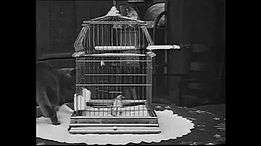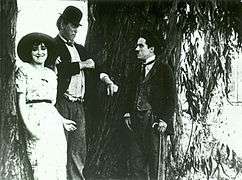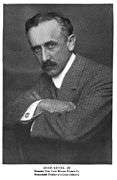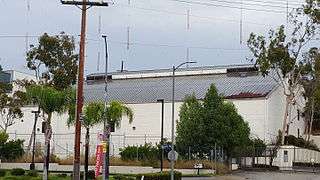Keystone Studios
Coordinates: 34°05′10.37″N 118°15′34.80″W / 34.0862139°N 118.2596667°W
 | |
| Industry | Film studio |
|---|---|
| Founded | 1912 (as Keystone Pictures Studio) |
| Defunct | 1935 |
| Headquarters | Edendale, Los Angeles |
Key people | Mack Sennett |
Keystone Studios was an early movie studio founded in Edendale, California (which is now a part of Echo Park) on July 4, 1912 as the Keystone Pictures Studio by Mack Sennett (1880-1960) with backing from actor-writer Adam Kessel (1866-1946)[1] and Charles O. Baumann (1874-1931), owners of the New York Motion Picture Company (founded 1909).[2][3] The company filmed in and around Glendale and Silver Lake, Los Angeles, California for several years, and its films were distributed by the Mutual Film Corporation between 1912 and 1915.[4]
The original main building, the first totally enclosed film stage and studio in history, is still standing. It is located at 1712 Glendale Blvd in Echo Park, Los Angeles.
Production
The studio is perhaps best remembered for the era under Mack Sennett when he created the slapstick antics of the Keystone Cops, from 1912, and for the Sennett Bathing Beauties, beginning in 1915. Charles Chaplin got his start at Keystone when Sennett hired him fresh from his vaudeville career to make silent films. Charlie Chaplin at Keystone Studios is a 1993 compilation of some of the most notable films Chaplin made at Keystone, documenting his transition from vaudeville player to true comic film actor to director. In 1915 Keystone Studios became an autonomous production unit of the Triangle Film Corporation with D. W. Griffith and Thomas Ince. In 1917 Sennett gave up the Keystone trademark and organized his own company.


Many other important actors also worked at Keystone toward the beginning of their film careers, including Marie Dressler, Harold Lloyd, Mabel Normand, Roscoe Arbuckle, Gloria Swanson, Louise Fazenda, Raymond Griffith, Ford Sterling, Ben Turpin, Harry Langdon, Al St. John and Chester Conklin.
Sennett, by then a celebrity, departed the studio in 1917 to produce his own independent films (eventually distributed through Paramount). Keystone's business decreased after his departure, and finally closed after bankruptcy in 1935.
Legacy
Much of the lighting and studio equipment from Keystone was bought by Reymond King - who started the "Award Cinema Movie Equipment" company in Venice, CA in November, 1935.
"Keystone Studios" is the fictional studio in the film Swimming With Sharks.
A new legal corporate entity named Keystone Studios began again during 2005. Keystone obtained its new trademark in 2006.[5]
The Keystone Studios lot was an explorable location, as well as a major plot element, in the 2011 video game L.A. Noire, published by Rockstar Games.
Gallery

 Charles Baumann
Charles Baumann Adam Kessel
Adam Kessel Keystone Studios building, Echo Park - Present Day
Keystone Studios building, Echo Park - Present Day
See also
- Category:Keystone Studios films
References
- ↑ Internet Movie Databse
- ↑ Silent Era.com
- ↑ MovieMoviesite.com
- ↑ Mutual Film Corporation at Silent Era. Retrieved 2012-01-30.
- ↑ Robertson, Willa (2007-07-18). "Cineville, Westlake create Keystone". Variety. Retrieved 2012-01-30.
Further reading
- Lahue, Kalton (1971); Mack Sennett's Keystone: The man, the myth and the comedies; New York: Barnes; ISBN 978-0-498-07461-5
- Neibaur, James L. (2011); Early Charlie Chaplin: The Artist as Apprentice at Keystone Studios; Lanham, MD: Scarecrow Press; ISBN 978-0-8108-8242-3
- Walker, Brent (2009); Mack Sennett's Fun Factory Jefferson, NC: McFarland and Co. ISBN 978-0-7864-3610-1
External links
![]() Media related to Keystone Studios at Wikimedia Commons
Media related to Keystone Studios at Wikimedia Commons